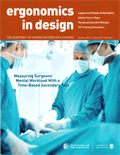
Ergonomics in Design
Scope & Guideline
Fostering multidisciplinary dialogue for ergonomic excellence.
Introduction
Aims and Scopes
- Human-Centered Design:
The journal emphasizes research that prioritizes user needs and preferences in the design process, ensuring that products and environments are tailored to enhance usability and comfort. - Ergonomic Assessment and Evaluation:
A significant focus is placed on the evaluation of ergonomic principles in design, assessing how well products and systems accommodate human capabilities and limitations. - Interdisciplinary Applications of Ergonomics:
The journal explores the application of ergonomic principles across various fields, including healthcare, technology, and everyday consumer products, showcasing the versatility of ergonomics. - Innovative Design Solutions:
Research often highlights novel design interventions and tools that address specific ergonomic challenges, aiming to improve efficiency and safety in diverse settings. - Technological Integration in Ergonomics:
The journal includes studies on the integration of emerging technologies, such as virtual reality and machine learning, in ergonomic design processes and user experience enhancements.
Trending and Emerging
- Aging and Accessibility in Design:
Research focusing on the needs of aging populations and accessibility in design is gaining momentum, highlighting the importance of creating inclusive environments and products. - Human-Autonomy Teaming:
There is an increasing exploration of human-autonomy interactions, particularly in contexts like military and healthcare, emphasizing the design of systems that support effective collaboration between humans and autonomous agents. - Cognitive Ergonomics and Trust:
Emerging studies are delving into cognitive aspects of ergonomics, particularly trust in technology and decision-making processes, which are critical in high-stakes environments. - Sustainability and Ergonomics:
A trend towards integrating sustainability into ergonomic design is evident, with research focusing on environmentally friendly materials and practices that promote user well-being without compromising ecological integrity. - Digital Therapeutics and Health Technologies:
The journal is increasingly publishing research on the design and evaluation of digital health interventions, reflecting a growing interest in technology's role in enhancing health and well-being.
Declining or Waning
- Traditional Anthropometric Studies:
Although anthropometric studies remain relevant, there seems to be a diminishing emphasis on purely traditional measurements, as newer technologies and methodologies, such as 3D scanning, gain traction. - General Commentary and News Articles:
The frequency of general commentary and news pieces has decreased, suggesting a shift towards more focused research articles that provide in-depth analysis and empirical findings. - Static Ergonomic Evaluations:
Research centered on static ergonomic evaluations is becoming less common, possibly due to the growing interest in dynamic and contextual assessments that consider real-world variability. - Simplistic Usability Testing:
There is a noticeable decline in studies that solely focus on basic usability testing without integrating comprehensive human factors analysis, indicating a trend towards more complex and multifaceted evaluations.
Similar Journals

Multimodal Technologies and Interaction
Advancing Interdisciplinary Dialogue in Technology.Multimodal Technologies and Interaction, published by MDPI since 2017, is an esteemed open-access journal based in Switzerland, dedicated to the exploration and advancement of innovative multimodal systems that enhance user experience across various digital platforms. With its commitment to disseminating high-quality research in diverse areas such as Computer Networks and Communications, Human-Computer Interaction, and Neuroscience, the journal has rapidly established itself within the academic community, achieving a commendable position in Scopus rankings including Q2 in both Computer Networks and Communications and Computer Science Applications. As an essential resource for researchers, professionals, and students alike, Multimodal Technologies and Interaction fosters interdisciplinary dialogue and supports the development of cutting-edge technologies, ensuring that advancements in multimodal interaction are accessible to a global audience. Scholars can benefit from its Open Access format, allowing unrestricted access to influential studies that shape the future of technology and interaction design.
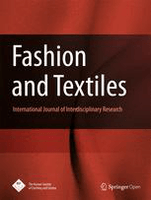
Fashion and Textiles
Connecting Research with Fashion's FutureFashion and Textiles is a distinguished open-access journal published by Springer, focusing on the interdisciplinary realms surrounding fashion, textile innovation, and their socio-cultural implications. Since its inception in 2014, this journal has aimed to foster a deeper understanding of the rapidly evolving landscape of fashion and textiles through rigorous research and scholarly discourse. With an impressive Q1 ranking in Cultural Studies and prominent positions in several other categories, including Marketing and Social Psychology, the journal holds a significant place in its field. The journal, based in Singapore and accessible globally, provides authors and readers with a platform for high-quality research exchanges that influence both academia and industry practices. Open access since its launch, it has proven to be an essential resource for researchers, practitioners, and students who seek to contribute to and engage with the latest trends and developments in fashion and textiles.

Zentralblatt fur Arbeitsmedizin Arbeitsschutz und Ergonomie
Empowering Professionals through Innovative Health InsightsZentralblatt für Arbeitsmedizin, Arbeitsschutz und Ergonomie, published by Springer Heidelberg, is a pivotal academic journal dedicated to the fields of public health, occupational safety, and ergonomics. With an ISSN of 0944-2502 and an E-ISSN of 2198-0713, this journal has been serving the academic community since its inception in 1953, covering a breadth of topics related to workplace health and safety practices. Although currently classified in the Q4 quartile in Public Health, Environmental, and Occupational Health, the journal continues to publish valuable research that impacts both practitioners and policymakers in these essential fields. The journal’s scope encompasses a wide range of studies, evaluations, and methodologies aimed at improving occupational health standards and ergonomic practices. With access options that facilitate global dissemination of knowledge, it aims to foster collaboration and innovation among professionals, researchers, and students committed to enhancing workplace well-being and safety.
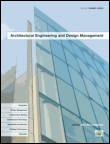
Architectural Engineering and Design Management
Connecting research and practice in architectural engineering excellence.Architectural Engineering and Design Management, published by Taylor & Francis Ltd, is a leading journal dedicated to the interdisciplinary fields of architectural engineering and design management. Since its inception in 2005, the journal has established itself as an essential resource for researchers and practitioners, showcasing the latest developments and innovative practices within the architecture and construction industries. With a commendable impact factor reflected in its Q1 ranking in Architecture and high standings across building and construction, it addresses critical themes such as sustainable design, integrated construction processes, and management strategies that drive efficiency and creativity in evolving architectural contexts. Researchers will find the journal's commitment to disseminating high-quality research—evidenced by its impressive Scopus rankings, including a #13 ranking in Architecture—particularly valuable as it fosters a deeper understanding and advancement in the profession. The journal is accessible in print and online, ensuring that academic and professional communities stay at the forefront of architectural engineering innovation.

Design Journal
Shaping Tomorrow's Design Practices TodayDesign Journal, published by Routledge Journals, Taylor & Francis Ltd, serves as a pivotal platform for interdisciplinary research within the expansive fields of Arts and Humanities as well as Computer Graphics and Computer-Aided Design. With an ISSN of 1460-6925 and an E-ISSN of 1756-3062, this journal is dedicated to disseminating innovative ideas and methodologies that shape contemporary design practices. Ranked in the Q2 category in Arts and Humanities and Q3 in Computer Graphics per the 2023 category quartiles, it stands as a reference point for scholars and practitioners alike, fostering a vibrant community for sharing knowledge and fostering creativity. Researchers will find the journal's scope particularly valuable as it covers a diverse range of topics, providing insights critical for advancing knowledge and practice. With the journal continuing to evolve—converging research avenues from 2005 to 2024—it thrives as a beacon of scholarly excellence in the United Kingdom and beyond, appealing to professionals, researchers, and students eager to engage with cutting-edge design discourse.

Design Science
Connecting Ideas, Inspiring Design Innovation.Design Science, published by Cambridge University Press, is a premier open access journal that has established itself as a leading platform for innovative research in the interdisciplinary field of design. Since its inception in 2015, the journal has focused on integrating design theories with practical applications across various sectors, including engineering, visual arts, and simulation modeling. With a remarkable impact factor and high rankings in multiple categories—Rank #11/667 in Visual Arts and Performing Arts and Rank #79/307 in General Engineering—Design Science commands a prominent position, being ranked in the top 98th, 76th, and 74th percentiles within its respective fields according to Scopus. The journal's dedication to open access ensures that cutting-edge research is accessible to a global audience, fostering collaboration and dialogue among researchers, professionals, and students alike. This journal not only aims to advance the understanding of design sciences but also serves as a vital resource for those seeking to explore the evolving dynamics of design practice in a rapidly changing technological landscape.
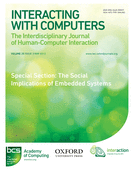
INTERACTING WITH COMPUTERS
Fostering Dialogue in the Evolving Tech LandscapeINTERACTING WITH COMPUTERS is a renowned journal published by Oxford University Press, focusing on the interdisciplinary field of Human-Computer Interaction, as well as aspects of Library and Information Sciences and Software. With a rich history of publication since 1989, this journal has established itself as a significant platform for scholars to disseminate cutting-edge research and innovative methodologies that enhance our understanding of how humans engage with technology. Despite being classified in the Q3 and Q2 quartiles across various categories, its 2023 Scopus rankings highlight its relevance, positioning it within the 69th percentile for Library and Information Sciences. This makes it an essential resource for researchers, professionals, and students looking to stay informed about the latest advancements and discussions in this rapidly evolving domain. Though not currently open access, INTERACTING WITH COMPUTERS offers substantial insights that are crucial for driving forward the conversation in Human-Computer Interaction, ensuring its relevance in both academic and applied contexts.

Design Studies
Illuminating the Path of Architectural ExcellenceDesign Studies, published by Elsevier Science Ltd, is an esteemed international journal, recognized for its pivotal contributions to the fields of design, architecture, and engineering. With an impressive history spanning from 1979 to 2024, this journal holds top positions in various categories, including Q1 rankings in Architecture, Arts and Humanities, and Engineering, indicating its high impact and relevance within academic circles. It boasts a notable Scopus ranking of #3 in Engineering & Architecture and #10 in General Social Sciences, demonstrating its multidisciplinary influence and the value it brings to both theoretical and practical aspects of design. Although not an open-access publication, the journal provides comprehensive access options to facilitate the dissemination of groundbreaking research. Catering to researchers, professionals, and students alike, Design Studies aims to foster innovation by publishing high-quality articles that explore contemporary design challenges and solutions, making it an essential resource for those invested in advancing knowledge in this dynamic field.

She Ji-The Journal of Design Economics and Innovation
Innovating Tomorrow through Design and Economic InsightShe Ji - The Journal of Design Economics and Innovation is a pioneering Open Access journal published by Elsevier since 2015, based in the Netherlands. With its unique focus on the intersection of design, economics, and innovation, this journal serves as a vital platform for researchers, professionals, and students who are keen on understanding the complexities of designing value-creating innovations. Consistently recognized for its high impact, She Ji holds a prestigious Q1 quartile ranking in both Economics and Education, while maintaining a strong presence in Management of Technology and Innovation and the Visual Arts sector. This reflects its commitment to fostering interdisciplinary dialogue and advancing knowledge in the rapidly evolving fields of design and economic theory. Researchers seeking to disseminate their work can benefit from the journal's robust open access model, ensuring wide visibility and accessibility to their findings. With a commitment to excellence, She Ji continues to shape thought leadership in its field and is an essential resource for anyone involved in the integration of design thinking with economic innovation.
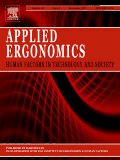
APPLIED ERGONOMICS
Shaping the Future of Ergonomics with Groundbreaking ResearchWelcome to Applied Ergonomics, a premier journal dedicated to advancing knowledge and practice in the multidisciplinary field of ergonomics and human factors. Published by Elsevier Science Ltd, this esteemed journal features a diverse range of research covering critical aspects of physical therapy, human factors, safety, and engineering. With an impressive impact factor and consistently ranked in the Q1 category across multiple domains—including Engineering, Human Factors and Ergonomics, and Safety—Applied Ergonomics serves as a vital resource for researchers, professionals, and students aiming to enhance user experience and optimize workplace safety. With its extensive historical archive dating back to 1969 and continuing through 2025, this journal encourages the dissemination of innovative applications and research findings that contribute to the ergonomics body of knowledge. For those interested in cutting-edge research that directly impacts health and safety practices, Applied Ergonomics is the authoritative source.